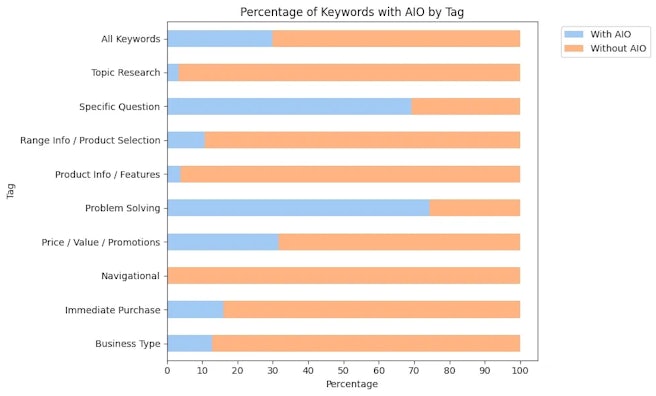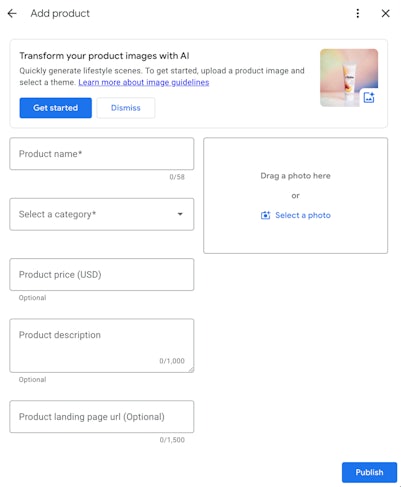This month, we bring you some exciting developments and updates from the world of search. Following a turbulent few months with the rollout of multiple core updates in quick succession, this month was a little quieter on that front. Instead, January was a month of new and updated guidance from Google, as well as some key insights regarding AI overviews.
AI Overviews (AIO) have become increasingly prevalent in search results, particularly for problem-solving queries. There has been more insight shared from Google, as well as more research on AIO being discussed.
Additionally, as more Large Language Models (LLMs) are gaining popularity, conversational AI, zero-click results and new consumer behaviours are also changing, placing new challenges to business strategies.
Google has published an update to their Search Quality Rater Guidelines, which defines and addresses AI-generated content while emphasizing the importance of providing unique value in content. The update reintroduces the three types of spam.
We’ll explore these updates and more in detail in the article below.
Allow our traffic light system to guide you to the articles that need your attention, so watch out for Red light updates as they’re major changes that will need you to take action, whereas amber updates may make you think and are definitely worth knowing but aren’t urgent. And finally, green light updates, which are great for your SEO and site knowledge but are less significant than others
Keen to know more about any of these changes and what they mean for your SEO? Get in touch or visit our SEO agency page to find out how we can help.
In this post, we’ll explore:
- Large language models are disrupting search – is your brand ready?
- LLMs drive traffic—but reduce direct site visits
- LLMs are now the “front door” of the web
- New challenges for brands
- How brands can adapt to LLMs
- The increasing presence of AI Overview for complex search queries
- Google AIO presence is expanding
- Authority and Brand Recognition in AIO
- YouTube Citations and AI Overview
- New insight from Google and User Search Intent Research for AI Overview
- Insights from Google’s John Mueller about the Future of SEO in the AI Era
- Google updates the Search Quality Rater Guidelines with new sections
- AI-Generated Content
- New spam categories
- Google Product Studio is now available within Google Business Profiles
- Key details about this new feature:
- Why it matters...
Large language models (LLMs) like ChatGPT and Google Gemini are reshaping search, leading to zero-click results, increased referral traffic and new challenges for brands. As LLMs become the new gatekeepers of the web, this post from Search Engine Land explores how businesses must adapt to this AI-driven landscape. We’ll take a closer look at the key findings from the article below.
LLMs drive traffic—but reduce direct site visits
Data from the article suggests that there was an 800% increase in referral traffic from LLMs from Q3 to Q4 in 2024. However, research from Gartner highlights that 50% of traditional search traffic could be lost in 3 years.
The cause of this has been linked to the rise of new features such as ‘one-click shopping’ which was introduced by Perpelexity and takes users directly to the checkout from the platform. This means users bypass branded websites and the traditional steps of online shopping.
LLMs are now the “front door” of the web
LLMs have changed the way that people access and engage with content on the web. Entry points to the web are diversifying with the rise of AI search which offers a more conversational approach to search.
Furthermore, the rise in in-app searches thanks to advancements within the Meta ecosystem and Meta’s Llama AI have further changed the way that people search with more users engaging with in-app searches on Instagram and Facebook.
New challenges for brands
While the advancement of features introduced by LLMs enhances the user experience, they also limit the insights available to marketers, making it harder to inform digital marketing strategies.
Unlike traditional search, where keyword data is accessible, LLMs provide no visibility into user prompts, making it difficult to understand intent. Additionally, rankings alone are no longer sufficient. Instead, accuracy, relevance, and sentiment now play a crucial role in visibility. To further complicate matters, LLM-generated results change daily and this throws up additional challenges which require continuous monitoring and strategy adaptation.
How brands can adapt to LLMs
To adapt to the rise of LLM-driven search, brands should focus on creating conversational content that aligns with AI interactions and natural language queries. Incorporating data, quotes and statistics can help boost credibility and increase the likelihood of being referenced in LLM responses. Maintaining brand accuracy across all platforms ensures consistency and improves recognition in AI-generated results. Additionally, tracking LLM mentions and competitor activity provides valuable insights that can help refine strategy and strengthen brand positioning in this evolving search landscape.
Google AIO presence is expanding
The integration of AIOs has led to notable changes in SERP layouts and it continues to evolve. Recent research from BrightEdge indicates that AI Overviews are now appearing in 25% of searches containing eight or more words, which is now at an all-time high. This trend suggests that Google is refining AIO’s accuracy, making it more effective at handling complex queries. While shorter keyword phrases continue to trigger AIO, the most significant growth is seen in longer, more precise search terms.

Authority and Brand Recognition in AIO
Google favours content from well-established brands, increasing its dominance over authoritative sources. For instance:
- Healthcare Queries: 72% of AIO answers now come from leading medical research centres which is a sharp rise from 54% in January.
- B2B Technology: 15-22% of AI Overview results derive from industry giants like Amazon, IBM, and Microsoft.
This shift highlights the importance of credibility and domain expertise in ranking for AI-generated search results.
YouTube Citations and AI Overview
BrightEdge also identified a fascinating change in how AI Overviews cite YouTube content:
- Technical tutorials: AI Overviews citing YouTube for how-to content increased by 40%.
- Health-related queries: YouTube citations declined by 31%.
- High-volume searches (100k+): The appearance of YouTube content dropped by 18.7%.
As Google improves its ability to determine the most suitable content format for different queries, marketers must ensure their content aligns with evolving search preferences.
As AI Overviews evolve, adapting content strategies to align with these trends will be crucial for maintaining search presence. AIOs now appear in 30% of searches and dominate problem-solving queries, featuring in 74% of such cases.
There are some patterns in how Google structures its AI-generated answers that brands need to consider:
- Step-by-step guidance: AIO excels in answering “how-to” questions with structured, hierarchical information.
- Real-time relevance: Answers are tailored to provide the most up-to-date and precise information.
- General guidance: AI Overviews tend to prioritise broad, easy-to-digest responses over dense, highly technical details.
For educational searches, Google favours concise, visually clean answers. Additional information might be helpful after the main query is often hidden, aligning with Google’s “information gain” approach. This anticipates what users need next without overwhelming them with excess data upfront.

In addition, there are some key findings from a recent study by Authoritas examined the impact of AIOs across 10,000 keywords and multiple industries, showing that:
- User intent matters: Problem-solving and informational queries trigger AIO most often, with 74% and 69% rates, respectively. Navigational searches rarely show AIOs.
- Non-brand terms are favoured: 33.3% of non-brand searches generate AIOs, compared to 19.6% for brand searches. AI Overviews influence brand perception early in the decision-making process.
- Impact on organic results: Expanding an AIO shifts search results by 220 pixels on desktop, reducing visibility for traditional organic listings, especially on mobile.
- Ranking and snippet influence: High-ranking pages often appear in AIOs, but not always. Featured Snippets have a 60%+ chance of being included in an AI Overview.
- Trust & authority matter: Google prioritises authoritative sources for finance and healthcare topics, while platforms like Reddit and Quora are less frequently cited.
From these findings, brands will need to keep in mind some takeaways for their SEO Strategy in the upcoming period:
- Focus on mid-volume, problem-solving keywords.
- Create authoritative, well-structured content to increase AIO inclusion.
- Optimise for Featured Snippets to boost AIO chances.
- Monitor organic visibility as AI Overviews reshape search dynamics.
In a recent interview with Mike Grehan, Google’s John Mueller shared insights on how SEO is evolving in the age of AI search. The discussion underscores the importance of adapting SEO strategies in response to AI’s growing role in search, urging marketers to think beyond traditional ranking tactics and embrace a more holistic marketing approach. He acknowledged that while SEO is often criticised, it is an integral part of the online ecosystem, helping users find what they need efficiently.
Apart from dismissing the idea that SEO is dead, Mueller reinforced the importance of technical SEO, mainly as AI-driven search and large language models depend on well-structured content. Ensuring websites remain accessible, indexable and optimised for AI search will continue to be vital.
Mueller and other experts in the discussion highlighted the need for SEO professionals to go beyond chasing clicks and rankings. Instead, they should focus on the value that their content delivers. SEO must evolve into a full-funnel marketing strategy prioritising user needs and brand presence rather than just traffic acquisition. With the emergence of AIO, SEOs should focus on providing concise, authoritative content to increase their chances of being featured in AI-generated answers.
Ryan Jones pointed out that user expectations have shifted as people want instant answers rather than navigating websites filled with ads and unnecessary content. SEOs must also adapt by ensuring their content is aligned with user intent, not just optimising for traditional search rankings.
Google has recently updated its Search Quality Rater Guidelines to address the evolving landscape of AI-generated content and to identify new forms of spam. The Search Quality Rater Guidelines are used by their team of human evaluators to assess content across the web and provide feedback to make search more useful for users.
These updates aim to ensure that search results continue to provide unique value to users.
AI-Generated Content
The updated guidelines clarify that while the use of AI tools is permitted in content creation, the resulting material must offer unique value to users. This means that AI-generated content should not merely replicate existing information but should provide original insights or perspectives. The emphasis is on the quality and uniqueness of the content, regardless of its origin.
New spam categories
To maintain the integrity of search results, Google has revised their three new spam categories:
- Expired Domain Abuse: This involves exploiting expired domains to manipulate search rankings. For example, acquiring a previously reputable domain and populating it with unrelated or low-quality content to benefit from its established authority.
- Site Reputation Abuse: This pertains to misrepresenting or fabricating a site’s reputation to deceive users. An example would be creating fake reviews or endorsements to falsely enhance a site’s credibility.
- Scaled Content Abuse: This involves mass-producing low-quality content to influence search visibility. For instance, generating a large number of pages with thin or duplicated content aimed solely at ranking in search results without providing real value to users.
These updates reflect Google’s commitment to enhancing the quality of search results by ensuring that all content, whether human or AI-generated, adheres to established standards and provides genuine value to users.
Google has integrated a new feature called “Product Studio” into Google Business Profiles, which allows merchants to edit the background of product images using AI. Previously available in Google Merchant Center and Google Ads, this feature helps businesses create more engaging product imagery.
Product Studio has only been rolled out in the US so far and they have yet to announce if this will be rolled out to wider markets.
Key details about this new feature:
- Merchants can now change background scenes for product images directly within their Google Business Profile.
- The process involves uploading an image, removing the background, selecting a theme, and choosing a generated version before saving and publishing.
- Currently, this feature is only available in the U.S.
- Google emphasises that using Product Studio requires agreeing to their Terms of Service.

Why it matters…
Google Business Profiles are essential for any local SEO strategy, helping brands improve their visibility in local searches. This new tool enhances product listings by making them more visually appealing, which can attract potential customers and drive higher conversions. This new tool can help businesses enhance their product listings, making them more visually appealing to potential customers, which could lead to better conversions.








